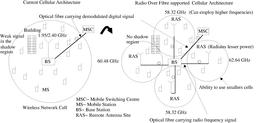Today's Computation Enabling Tomorrow's Seamless Communication
- Started
- 1st October 2011
- Ended
- 1st October 2015
- Research Team
- Varghese Thomas
- Investigators
- Lajos Hanzo
Radio Over Fiber (ROF) communication is an optical/wireless integration technique that would support the next generation of high-speed, ubiquitous wireless services. It involves transmitting radio frequency signals to and from a base station, which applies centralised processing to the signals that are received from a number of remote antennas as well as to the signals that are transmitted to the remote antennas. Little or no signal processing is done at the Remote Antenna Sites (RASs). The transmission and reception takes place through the high-bandwidth, low-attenuation optical fibres, in an effort to improve cellular coverage, capacity, data rates and power efficiency. These advantages have been illustrated in the accompanying figure. This technique enables a wireless network to support a large number of RASs, while keeping the cost per RAS low. Moreover, it enables efficient utilisation of the existing optical fibre networks and their employement in Heterogenous Networks (HetNets).
Exhaustive simulations and the optimization of these complex networks, prior to their real world deployment, is essential for these solutions to provide the desired performance. Both optical and wireless systems rely on sophisticated transmitter and receiver techniques and their joint, holistic optimization imposes a huge simulation complexity. Monte-Carlo simulations and the Split Step Fourier Method are some of the major computational algorithms that are employed in this project. The high-speed, parallel computing services that are offered by a supercomputer has potential applications in system simulation and optimization.
Categories
Physical Systems and Engineering simulation: Electromagnetism, Fiber Optic Communications, Photonics, Semiconductors, Wave propagation
Algorithms and computational methods: Distributed computing, FFT, Monte Carlo, Multi-core, Optimisation
Programming languages and libraries: C++, Matlab
Computational platforms: Iridis, Linux, Lyceum, Windows
Transdisciplinary tags: Complex Systems, Design, Digital Economy
